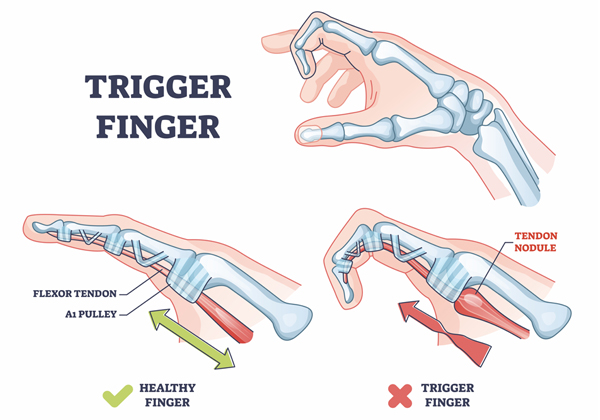Understanding Trigger Finger: Causes, Symptoms, and Treatment
An Overview
Do you experience a clicking sensation followed by difficulty straightening your finger? You might have trigger finger, a condition affecting the tendons in your fingers or thumb.
What is Trigger Finger?
Imagine your fingers bend and straighten because of flexible bands called tendons. These tendons glide smoothly within a tunnel-like structure called a tendon sheath. Trigger finger occurs when the tendon sheath becomes inflamed and thickened, making it difficult for the tendon to slide freely. This can cause your finger to catch, lock, or “pop” when you try to bend or straighten it.
What causes it?
Several factors can contribute to trigger finger, including:
- Repetitive hand activities: Jobs or hobbies that involve frequent gripping or forceful use of the fingers or thumb can irritate the tendon sheath.
- Age: Trigger finger is more common between the ages of 40 and 60.
- Medical conditions: Diabetes, rheumatoid arthritis, and gout can increase the risk.
Symptoms
Several factors can contribute to trigger finger, including:
- Catching or locking: The affected finger might get stuck in a bent position and require assistance to straighten.
- Clicking or popping: You might hear or feel a popping sensation when moving the finger.
- Pain and tenderness: You might experience pain and tenderness at the base of the finger or thumb, especially with movement.
- Stiffness: The finger might feel stiff, particularly in the morning.
Diagnosis
Our doctor will likely:
- Ask about your symptoms and medical history.
- Perform a physical examination to assess your finger movement and check for tenderness or swelling.
Treatment
Treatment options depend on the severity of your condition. They may include:
- Rest: Avoiding activities that aggravate the symptoms.
- Splinting: Wearing a splint to immobilize the finger and promote healing.
- Anti-inflammatory medication: Over-the-counter pain relievers can help manage pain and inflammation.
- Steroid injection: Injections of a powerful anti-inflammatory medication can reduce inflammation in the tendon sheath.
- Surgery: In severe cases, surgery might be necessary to release the thickened sheath and improve tendon movement.
Remember
Early diagnosis and treatment can help prevent complications and ensure a full recovery. If you experience persistent finger pain or difficulty straightening your finger, consult your doctor to discuss the best course of action for you.

